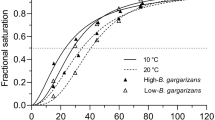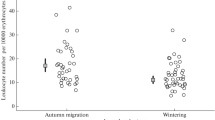Abstract
Parameters of hematopoietic tissue and peripheral blood in the Caucasian snow vole (Chionomys gud Satunin, 1909), a typical mountain species of small mammals, have been studied for the first time along a latitudinal–longitudinal (rather than altitudinal) gradient. It has been found that the blood of snow voles living at the same elevation (1800 m a.s.l.) in the maritime climate of the Western Caucasus and in the continental climate of the Central Caucasus has similar oxygen-carrying capacity, but this is provided by different mechanisms. The results of this study suggest that the natural conditions of the Western Caucasus are most optimal for the species.
Similar content being viewed by others
References
Sokolov, V.E. and Tembotov, A.K., Mlekopitayushchie Kavkaza: Nasekomoyadnye (Mammals of the Caucasus: Insectivores), Moscow: Nauka, 1989.
Tembotov, A.K., Shebzukhova, E.A., Tembotova, F.A., et al., Problemy ekologii gornykh territorii: Uchebnoe posobie dlya studentov (Problems in the Ecology of Mountain Areas: A Manual for Students), Maikop: Adyg. Gos. Univ. 2001.
Shvarts, S.S., Smirnov, V.S., and Dobrinskii, L.N., Metod morfofiziologicheskikh indikatorov v ekologii nazemnykh pozvonochnykh (The Method of Morphophysiological Indicators in the Ecology of Terrestrial Vertebrates), Sverdlovsk: Ural Fil. Akad. Nauk SSSR, 1968.
Bol’shakov, V.N., Puti prisposobleniya melkikh mlekopitayushchikh k gornym usloviyam (Pathways of Adaptation to Mountain Conditions in Small Mammals), Moscow: Nauka, 1972.
Bol'shakov, V.N. and Koval’chuk, L.A., Adaptation capacities of tissue oxidative metabolism and blood system in the Siberian brown lemming, Dokl. Akad. Nauk SSSR, 1984, vol. 274, no. 2, pp. 493–496.
Tembotova, E.Zh., Ecological analysis of the red blood system in the little ground squirrel (Cittelus pygmaeus Pall.) under conditions of altitudinal zonality of the Northern Caucasus, Extended Abstract of Cand. Sci. (Biol.) Dissertation, Sverdlovsk, 1975.
Tembotova, E.Zh., Uligova, Z.N., Baragunova, E.A., et al., Blood parameters of some mammals from the Caucasus, in Fauna, ekologiya i okhrana zhivotnykh Severnogo Kavkaza: Mezhved. sb. nauch. tr. (The Fauna, Ecology, and Protection of Mammals in the Northern Caucasus: Multidisciplinary Collected Papers), Nalchik: Kabardino-Balkar. Gos. Univ., 1980, pp. 65–81.
Panteleev, P.A., Terekhina, A.N., and Varshavskii, A.A., Ekogeografichekaya izmenchivost’ gryzunov (Ecogeographic Variation in Rodents), Moscow: Nauka, 1990.
Morrison, P., Kerst, K., Reynafarje, C., and Ramos, J., Hematocrit and hemoglobin levels in some Peruvian rodents from high and low altitude, Int. J. Biometeorol., 1963, vol. 7, no. 1, pp. 51–58.
Wyckoff, S.M. and Frase, B.A., Hematological adaptation to hypoxia in Peromyscus and Microtus at high and low altitude, Trans. III. State Acad. Sci., 1990, nos. 3–4, pp. 197–205.
Zongkun Zhu, Muyan He, Baolan Zhan, et al., Comparison of hypobaric hypoxia reference in hedgehogs, squirrels and rats, Beijing Daxuebao–Acta Sci. Nat. Univ. Perenensis, 1993, vol. 29, vol. 29, no. 2, pp. 184–190.
Ostrojic, H., Cifuentes, V., and Monge, C., Hemoglobin affinity in Andean rodent, Biol. Res., 2002, vol. 35, no. 1, pp. 27–30.
Storz, F.J., Hemoglobin function and physiological adaptation to hypoxia in high-altitude mammals, J. Mammal., 2007, vol. 88, no. 1, pp. 24–31.
Koval’chuk, L.A., Ekologo-fiziologicheskie aspekty adaptatsii k usloviyam tekhnogennykh ekosistem (Ecophysiological Aspects of Adaptation to the Conditions of Technogenic Ecosystems), Yekaterinburg: Ural. Otd. Ross. Akad. Nauk, 2008.
Barbashova, Z.I., Tavrovskaya, T.V., Tarakanova, O.I., et al., Comparative assessment of the mechanisms of adaptation to hypoxia in highland and lowland ground squirrels of the Northern Caucasus: 1. The status of the erythron, Ekologiya, 1976, no. 2, pp. 63–70.
Tembotov, A.K., Tembotova, E.Zh., Bersekova, Z.A., and Emkuzheva, M.M., Effect of terrain elevation gradient on hematological parameters of the Ural field mouse (Muridae, Rodentia), a widespread rodent species, in the Central Caucasus, in Mlekopitayushchie gornykh territorii: Mat-ly mezhdunar. konf. (Mammals of Mountain Regions: Proc. Int. Conf.), Moscow: KMK, 2005, pp. 169–174.
Tembotova, E.Zh., Emkuzheva, M.M., and Tembotova, F.A., Ecophysiological analysis of erythron in the house mouse (Mus musculus L.) under conditions of altitudinal zonality in the Central Caucasus, in Mlekopitayushchie gornykh territorii: Mat-ly mezhdunar. konf. (Mammals of Mountain Regions: Proc. Int. Conf.), Moscow: KMK, 2007, pp. 315–323.
Emkuzheva, M.M., Comparative analysis of adaptive responses to mountain conditions from the blood system and interior characters of wild and synanthropic Muridae rodents in the central part of the Northern Caucasus, Extended Abstract of Cand. Sci. (Biol.) Dissertation, Saratov, 2013.
Baragunova, E.A., Lampezheva, R.M., Sabanova, R.K., et al., Comparative characterization of hematological and morphophysiological parameters of European water voles (Arvicola terrestris rufescens Sat.) in populations from the mountains and foothills of the Central Caucasus, Sovrem. Probl. Nauki Obraz., 2017, no. 3, pp. 148–155.
Gromov, I.M. and Polyakov, I.Ya., Fauna SSSR. Mlekopitayushchie. Polevki (Microtinae) (The Fauna of the Soviet Union. Mammals: Voles (Microtinae)), Leningrad: Nauka, 1977, vol. 3, part 8.
Vereshchagin, N.K., Mlekopitayushchie Kavkaza (Mammals of the Caucasus), Moscow: Akad. Nauk SSSR, 1959.
Kuryatnikov, N.N., On reproduction of the Caucasian snow vole in the Central Caucasus, in Voprosy ekologii i biologii zhivotnykh severnykh sklonov Tsentral’nogo Kavkaza (Problems of Animal Ecology and Biology on the Northern Slopes of the Central Caucasus), Ordzhonikidze, 1976, pp. 105–113.
Kuryatnikov, N.N., Some features of stational distribution and biology of the Caucasian snow vole Chionomys gud Sat. in the Central Caucasus, in Ekologiya zhivotnykh severnykh sklonov Tsentral’nogo Kavkaza (Animal Ecology on the Northern Slopes of the Central Caucasus), Ordzhonikidze, 1978, pp. 26–30.
Dobrolyubov, A.N., Abundance, biotopic distribution, and morphological features of the Caucasian snow vole from the Teberda Nature Reserve, in Ekologiya, metody izucheniya i organizatsiya okhrany mlekopitayushchikh gornykh oblastei (Mammals of Mountain Regions: Ecology, Methods of Study, and Organization of Protection), Sverdlovsk, 1977, pp. 32–33.
Malikov, V.G., Comparative analysis of postnatal ontogeny in voles of the genera Microtus and Chionomys (Rodentia, Cricetidae), in Ekologiya i okhrana gornykh vidov mlekopitayushchikh (The Ecology and Protection of Mountain Mammal Species), Moscow, 1987, pp. 112–113.
Sablina, O.V., Radzhabli, S.I., Malikov, V.G., et al., On the taxonomic position of Chionomys voles according to karyological data, Zool. Zh., 1988, vol. 17, no. 3, pp. 472–475.
Kuliev, G.N., Chromosomal homology in representatives of the genera Chionomys and Pitymys, in V s”ezd Vsesoyuznogo teriologicheskogo obshchestva AN SSSR (Proc. V Congress of All-Union Theriological Society, USSR Acad. Sci.), Moscow, 1990, pp. 74–76.
Khulamkhanova, M.M., Specific ecological and biological features of the Caucasian snow vole (Chionomys gud Satunin, 1909) in the Caucasus, Extended Abstract of Cand. Sci. (Biol.) Dissertation, Makhachkala, 2007.
Dzuev, R.I., Sizhazheva, A.M., and Bannikova, A.A., Intraspecific genetic structure of the Caucasian snow vole (Chionomys gud Satunin, 1909) inferred from mitochondrial DNA analysis, Izv. Kabardino-Balkar. Gos. Univ., 2011, vol. 1, no. 4, pp. 35–42.
Sizhazheva, A.M., Molecular-genetic and ecological diversity of the genus Chionomys in the Caucasus, Extended Abstract of Cand. Sci. (Biol.) Dissertation, Vladikavkaz, 2012.
Bannikova, A.A., Sizhazheva, A.M, Malikov, V.G., et al., Genetic diversity of Chionomys genus (Mammalia, Arvicolinae) and comparative phylogeography of snow voles, Russ. J. Genet., 2013, vol. 49. no. 5, pp. 561–576.
Bottaeva, Z.Kh., Tembotova, F.A., Bersekova, Z.A., et al., Ecogeographic variability of peripheral blood immunological parameters in the Caucasian snow vole (Cricetidae, Rodentia) from the mid-mountain regions of the Western and Central Caucasus, Izv. Samarsk. Nauch. Tsentra Ross. Akad. Nauk, 2016, vol. 18, no. 5, pp. 83–88.
Dzuev, R.I., Khulamkhanova, M.M., and Sizhazheva, A.M., Molekulyarnaya sistematika i ekologo-biologicheskie osobennosti gudaurskoi polevki (Chionomys gud Satunin, 1909) na Kavkaze (Molecular Systematics and Specific Ecological and Biological Features of the Caucasian Snow Vole (Chionomys gud Satunin, 1909) in the Caucasus), Makhachkala: Eko-Ekspress, 2011.
Climate Data for Cities Worldwide. http://ru.climatdata. org.
Karaseva, E.V., Telitsyna, A.Yu., and Zhigal’skii, O.A., Metody izucheniya gryzunov v polevykh usloviyakh (Methods of Field Studies on Rodents), Moscow: LKI, 2008.
Todorov, I., Klinicheskie laboratornye issledovaniya v pediatrii (Clinical Laboratory Studies in Pediatrics), Sofia: Meditsina i Fizkul’tura, 1968.
Analizy. Polnyi spravochnik (Analyses: A Comprehensive Guidebook), Eliseeva, Yu.Yu., Ed., Moscow: Eksmo, 2006.
Tarakhtii, E.A. and Davydova, Yu.A., Seasonal variation in hematological indices in bank vole (Clethrionomys glareolus) in different reproductive states, Biol. Bull., 2007, vol. 34, no. 1, pp. 9–19.
Gorbunova, N.A., Erythrodieresis in extreme conditions and its role in blood regeneration, Gematol. Transfuziol., 1985, no. 2, pp. 23–27.
Kliorin, A.I. and Tiunov, L.A., Funktsional’naya neravnoznachnost’ eritrotsitov (Functional Nonequivalence of Red Blood Cells), Leningrad: Nauka, 1974.
Pantskhava, A.D., Kachestvennye izmeneniya eritrotsitov v perifericheskoi krovi (Qualitative Changes in Peripheral Red Blood Cells), Tbilisi: Sabchota Sakartvelo, 1961.
Tembotov, A.K., Geografiya mlekopitayushchikh Severnogo Kavkaza (Geography of Mammals of the Central Caucasus), Nalchik: El’brus, 1972.
Barbashova, Z.I., Akklimatizatsiya k gipoksii i ee fiziologicheskie mekhanizmy (Acclimation to Hypoxia and Its Physiological Mechanisms), Moscow: Akad. Nauk SSSR, 1960.
Bulatova, N.N., Specific features of high-mountain animals, Tr. Inst. Morfol. Zhivotn. im. A.N. Severtsova, 1962, no. 41, pp. 11–43.
Ekologicheskaya fiziologiya zhivotnykh (Ecological Physiology of Animals), part 3: Fiziologiya zhivotnykh v razlichnykh fiziko-geograficheskikh zonakh (Animal Physiology in Different Physiographic Zones) Slonim, A.D., Ed., Leningrad: Nauka, 1982.
Author information
Authors and Affiliations
Corresponding author
Additional information
Russian Text © Z.Kh. Bottaeva, F.A. Tembotova, M.M. Emkuzheva, Z.A. Bersekova, A.Kh. Chapaev, 2019, published in Ekologiya, 2019, No. 1, pp. 30–39.
Rights and permissions
About this article
Cite this article
Bottaeva, Z.K., Tembotova, F.A., Emkuzheva, M.M. et al. Effect of Ecogeographic Factors along Latitudinal–Longitudinal Gradient on the Red Blood System of the Caucasian Snow Vole (Chionomys gud), a Species Autochthonous to the Caucasus. Russ J Ecol 50, 34–42 (2019). https://doi.org/10.1134/S1067413619010016
Received:
Revised:
Accepted:
Published:
Issue Date:
DOI: https://doi.org/10.1134/S1067413619010016




